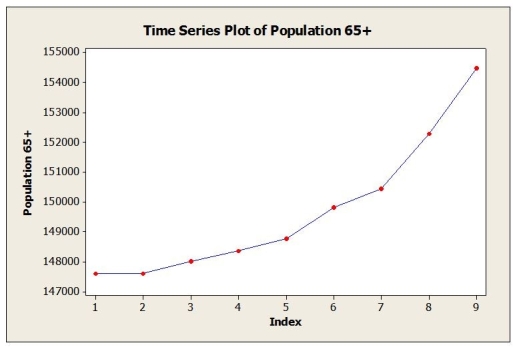Annual estimates of the population in the age group 65+ in a mid-sized city from 1999 (t = 1) onward are shown in the time series graph below.  a. Identify the dominant time series component(s) in the data.
a. Identify the dominant time series component(s) in the data.
b. Below are the results from fitting a linear trend model to the data. Use this model to estimate the 65+ population in this city for 2008 (t = 10).  c. Below are the results from fitting a quadratic trend model to the data. Use this model to estimate the 65+ population in this city for 2008 (t = 10).
c. Below are the results from fitting a quadratic trend model to the data. Use this model to estimate the 65+ population in this city for 2008 (t = 10).  d. The actual population estimate for 2008 is 157,218. Which model does better? Why?
d. The actual population estimate for 2008 is 157,218. Which model does better? Why?
Definitions:
Q8: A type I error is committed when<br>A)
Q15: Quarterly returns were forecasted for a mutual
Q20: At α = 0.05<br>A) We can conclude
Q24: Sociological philosophers are unlikely to adhere to
Q25: Assume that the year 2000 is used
Q25: What characteristic of the American legal system
Q31: Based on the 95% confidence interval, should
Q34: The Durbin-Watson statistic indicates<br>A) that the residuals
Q38: What is the probability that the sample
Q56: What is the first step in examining